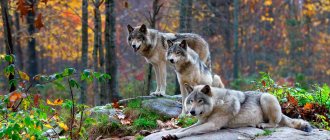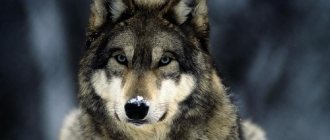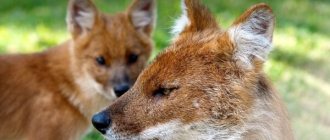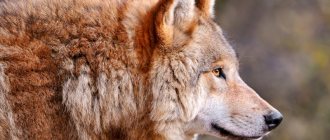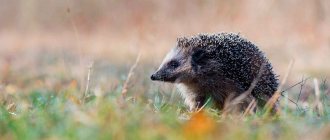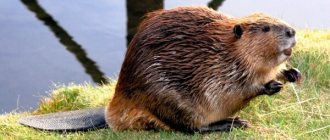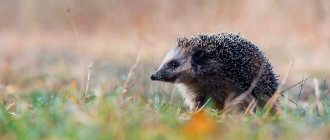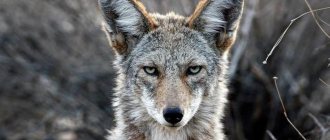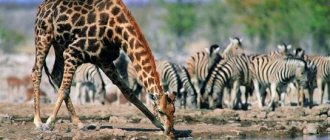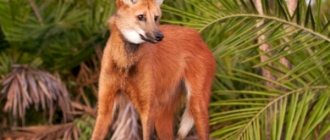22 November 130121canine family predator wolf-dangerous
Everyone remembers the fairy tale about the gray wolf that we were told in childhood. So who exactly is a wolf? An image from a fairy tale or a dangerous animal? The common wolf is a large predator of the Canidae family. The gray wolf is the master of the tundra and taiga, a hardy and very intelligent animal. In this article you will find a description and photo of a wolf and learn a lot of interesting things about the harsh life of this formidable predator.
Wolves: their habits and lifestyle
Throughout human history, wolves and people have always lived side by side. These predators have always posed a danger to humans. They attacked livestock and sometimes humans. Therefore, people have always sought to destroy these predators by all means and means.
Wolves were poisoned, killed with guns, caught in traps and nooses, etc. In recent years, airplanes and helicopters, snowmobiles, etc. have been used against wolves. Despite all these measures, wolves continue to live.
True, in many countries of Western Europe there are no wolves for a long time, but there are few conditions for their life there. Wolves are very flexible and live in a wide variety of climatic conditions. They live in the taiga and tundra, in the steppes and deserts, in cities and swamps.
There is a known case when a pair of wolves lived in the center of Moscow for almost two years. Of course, they ended up there due to human fault, but, having been thrown out onto the street as puppies, they were able to adapt to life in the city. They caught rats and later stray dogs and cats. People did not even suspect that these dangerous predators lived next to them.
Wolves are adapted to hunting large ungulates, but they feed not only on the meat of these animals. They catch mice and rats, hares and squirrels, frogs and lizards. During the years of peak numbers of mouse-like rodents, wolves largely feed on them, which brings certain benefits to forestry.
Scientists, studying the life of these predators, have long come to the conclusion that wolves devour, first of all, sick and weak animals. Wolves have historically been regulators of the numbers of many game animals. There can be no talk of complete elimination of the wolf in our country.
Varieties
Although more than 35 subspecies have been identified in the wolf family, let’s consider the most notable of them:
- White – has a peaceful character and beauty. He prefers to hide from his enemies, including people. Lives in the tundra and Arctic.
- Black is very similar to a dog, with which people often confuse him. The predator's habitat is Alaska and North America.
- Red - resembles a short-tailed fox. In size it is inferior to its “gray” relatives. He loves rocky mountains and gorges, where he lives.
- Steppe - has a small size. Lives in the steppes. It is noteworthy that it uses fox holes for living. Hunts marmots, hares and partridges.
The common or gray species is not mentioned here, since the main story will be about it.
Is a wolf dangerous for humans?
During the Great Patriotic War, when the persecution of wolves almost completely stopped, their numbers increased greatly. The wolves began to lack food. Hunger and lack of fear of humans contributed to wolf attacks on humans, mainly children.
In the Kirov, Kostroma and Volgograd regions, more than two dozen cases of children dying from wolves were officially registered. Of course, only individual individuals specialized in this fishery. After the end of the Great Patriotic War, when the persecution of wolves began again, cases of wolf attacks on humans became very rare.
It should be noted that the wolf, of which man has always felt fear, was surrounded by the halo of a fairy-tale character, where the wolf always played the role of the bearer of evil. And this is not only in fairy tales. You can often hear terrible stories about attacks by packs of wolves on people. In fact, when checked, all these rumors are not confirmed by anything.
And yet the wolf poses a danger to humans. Animals with rabies are especially dangerous because they lose their fear of humans.
First of all, those animals that hunt dogs and enter populated areas must be destroyed.
By the beginning of the last century in the United States, people exterminated almost all wolves
Photo: Philipp Pilz
As settlements grew in the southern United States, so did the belief that livestock populations were in danger of extinction due to large wolf populations. As a result, in the middle of the 20th century there were up to several hundred individuals there. Following this, successful wolf restoration plans were developed throughout the country. There are currently approximately 2,600 wild wolves in the southern United States.
Populations in Alaska and Canada remain stable and fairly large. There are currently between 6,000 and 8,000 wolves in the state of Alaska, and the Canadian population is estimated at approximately 50,000. Wolves in Canada are protected by local governments and are not currently endangered.
In western Eurasia, wolf populations have declined to isolated small packs in Poland, Scandinavia, Russia, Portugal, Spain and Italy. Wolves were extirpated from the British Isles in the 1700s and nearly disappeared from Japan and Greenland in the 20th century. Greenland wolf populations now appear to have fully recovered. The status of wolves in much of eastern Eurasia is poorly understood, but populations are likely stable in many areas.
Description of the wolf and characteristics
The wolf is the largest representative of the canine family. No one knows for sure when the ancestors of our domestic dog divided into two groups: the domestic dog and the gray wolf. It is believed that this happened about 4`000`000 years ago.
Probably, primitive man was accompanied by a certain wolf-like animal that devoured the remains of his prey. Over time, this creature sacrificed its freedom for the sake of food, which benefited not only him, who later turned into a dog.
The dog learned to help man on the hunt, guarded the herds of animals he had domesticated, and sometimes even protected man from wild animals, thus becoming necessary and useful for him. The wolf and the dog are very close to each other, which follows at least from the fact that they often interbreed and produce offspring.
Wolf dimensions
Most adult gray wolves weigh between 34 and 56 kilograms. There is reliable data that they can reach 79 kilograms.
Males are usually larger and heavier than females by about 25%. Wolves appear larger due to their long fur. In winter, it reaches 5-6.3 centimeters on the back and sides, and from 10 to 12.7 centimeters on the shoulder blades, but due to contraction of the erector muscle, the hair stands on end, and the wolf appears even larger.
The length of their body is 1.8-2.3 meters, with the tail accounting for a quarter of the length of the animal. In 1969, a wolf skin measuring 2.27 meters from nose to tail was hung in Aniak, Alaska.
The height of the wolf can be 68-78 centimeters. Compared to dogs of the same size, wolves are much narrower in the chest. In proportion to the total weight, the legs of a wolf are also longer than those of dogs. Due to the fact that the wolf's chest is narrower than that of a dog, its footprint between the right and left paws is also much narrower than that of dogs.
The structure of the legs and the speed of the wolf
All canine animals are digitigrade, that is, they walk using only their toes. The wolf touches the ground with its heels only when it descends and lies on the ground.
The wolf's front legs are extremely large, which is of great importance: due to this, the load is distributed more evenly, and the wolf does not fall into the loose snow. The wolf has five toes on each front paw, although only four are active. The claws are strong and dull due to constant contact with the ground.
The wolf also uses them when digging the ground. Wolves walk, jog, and skip or gallop. Their walking speed is about 6.4 kilometers per hour. They usually jog at different speeds, usually 12.8-16 kilometers per hour.
For a long time, wolves can run almost without stopping. They are known to cover a distance of 96 kilometers in one night. The speed of the wolves during measurements reached 64 kilometers per hour. They ran like this for several miles.
Appearance of a wolf
Once a year, wolves change their skins. The long winter coat stays in clumps until late spring. Young fur immediately grows back, and a new winter coat is gradually formed. Although most wolves are gray, as reflected in their name, their coloration can vary from yellow mixed with gray and black to gray to pure white to jet black, although arctic wolves are usually white.
Wolves are highly intelligent creatures, as evidenced by erect ears, an attentive gaze, a pointed, elongated muzzle and some other signs. Their head shape resembles that of the German Shepherd, which shepherds use to guard sheep, although the wolf's skull is wider and more massive. The wolf's muzzle is also framed by a ring of long hair that looks like sideburns.
The long and very fluffy tail of the wolf is an important anatomical feature of this animal. When going to bed at night, the wolf curls up into a ball and covers his nose and legs with his tail, which are exactly in the center of the circle. Thanks to this position of the tail, the warm air exhaled from the lungs warms the paws and nose well.
Cold air also warms up upon entering, and thus the wolf breathes warm air. The long whiskers on the wolf's muzzle serve as olfactory organs. The cleft palate contains forty-two teeth: 12 incisors, 4 canines, 16 molars, 10 false molars and molars.
The wolf's fangs, 2.54 centimeters high, are long, strong, sharp and slightly curved, with which the wolf captures prey. The wolf does not chew food, but uses its false-rooted teeth to cut off pieces of meat that it can swallow at one time.
Wolf's feelings
Smell plays a very important role in the life of a wolf. He himself has several special glands. The odors produced by these glands are as specifically individual as our fingerprints. The wolf's sense of smell is very highly developed.
It can detect prey at a distance of up to 3 kilometers. Wolves usually wander for a long time, but when they smell prey, they immediately head towards it. Like all predators, wolves occupy a specific territory, which they mark with urine, feces and deep scratches on the ground.
They mark not only the borders, but also the paths along which they walk. Their marks are located at a distance of about 90 meters from each other. Wolves have very keen vision, and they quickly notice the slightest movement in front of them. Since wolves are primarily predators, their eyes are located on the front of their heads.
The field of vision is probably just under 180 degrees, unlike their victims, who have a field of view of over 300 degrees.
The wolf has a voice
The variety and frequency range of wolves' vocal means significantly exceeds the capabilities of the vast majority of animals (except humans and bats). Wolves make sounds such as howls, howls, whimpers, grunts, growls, yelps, and barks. Each sound has a huge number of variations.
The wolves' reaction to these sounds is conscious. With the help of their voice, wolves can convey very complex messages - about the presence of a certain animal in a certain place.
The signal for an attack among wolves is a battle cry given by the leader of the pack. This sound is similar to the growl of an angry dog rushing at a person.
Wolves howl at dawn or dusk, but not every day. The howl begins with a solo howl of the leader, which differs significantly from the howl of other members of the pack. They join a little later. The choral howl usually ends in a yapping, shrill bark.
The gestation period lasts from 60 to 63 days
Litter sizes range from one to fourteen cubs, with the average litter size consisting of 6-7 cubs. Wolf cubs are born blind and deaf. They weigh approximately 0.5 kg and depend on the warmth of their mother. At 10-15 days of age, wolf cubs open their eyes, but at this age they can only control their front legs, so crawling is their only way of moving. After five to ten days, the young can stand, walk and make sounds.
Non-breeding females will help raise the young and "look after them". Until 45 days of age, they are fed regurgitated food by all members of the flock. After reaching this age, wolf cubs begin to be fed meat. They remain in the den until they are 8-10 weeks old. Females stay with their young for almost 3 weeks.
Photo: ML
Between days 20 and 77, wolf cubs leave the den for the first time and learn to defend themselves by fighting with other wolf cubs. Interactions during this time, as well as the dominant status of the mother, ultimately determine their position in the pack hierarchy. Wolf cubs develop quickly, they must be large and developed enough to hunt with the pack when winter comes. At about ten months of age, the young begin hunting with a pack. Most young wolves leave their native pack between the ages of 1 and 3 years.
Habits and lifestyle of wolves
Life in a pack and howling are the most characteristic features of a wolf. They distinguish it from many other mammals and give uniqueness to its biological appearance.
A pack is a family group consisting of animals of different ages sharing a territory. Typically, a flock consists of parents, newborns (this year's brood) and youngsters (animals that have not reached sexual maturity). But very often it also includes several adult animals, apparently not taking part in reproduction. The size of the flock varies widely.
Its average size is 5-11 animals, but there are also very large flocks - from 15 to 22 individuals. Wolves stay in the most compact groups in winter, and in more dispersed groups in summer. The pack disbands in late spring, when the adult male and female separate from the pack to breed and raise their pups. But the remaining members of the flock in spring and summer do not leave the family territory and remain without forming large clusters.
Zoologists associate the main advantage of the pack lifestyle of wolves with hunting large ungulates. The size of a family territory depends greatly on the landscape and varies within very wide limits. The largest family plots are in open landscapes of tundra, steppe or semi-desert, where they reach 1000 - 1250 km. In the forest zone they are smaller - 200 - 250 km.
Most zoologists believe that wolves are monogamous, that is, one male forms a mating pair with the same female for many years. However, it is difficult to say that this is exactly the case, because a flock usually contains several mature males and females.
Fur
Wolves have very abundant fur, which consists of 2 layers: an undercoat and an outer layer. The undercoat has the property of not allowing water to pass through.
The top layer consists of special hairs that prevent dirt and water from reaching the undercoat. Also, wolf hair practically does not conduct temperature, which means that wolves can survive even in the harshest conditions.
Brief description of the wolf
Wolves are a genus of dangerous predatory mammals belonging to the canine family. Due to their habits, appearance, strength and intelligence, they are very famous animals.
By the way, dogs are domesticated wolves.
These canine representatives are the largest in their family. At the withers, the height of the wolf is 60-90 cm, while the body length can exceed one and a half meters (excluding the length of the tail).
The weight of the animal is 40-70 kg. And this is quite enough to fight on equal terms with many other predatory animals. And if you also consider that wolves live mainly in packs, it becomes clear why they are considered so dangerous.
Wolf color and some of its physiological characteristics depend on the type of animal.
There are about a dozen of them in total (depending on terrain conditions). But in general, they are all quite similar in body structure. By the way, many breeds of large dogs are also very similar to them (Siberian Husky, Tamaskan and others).
If you try to describe this beautiful predator in a few words, you get the following: high and strong legs, an elongated body covered with thick fur and coarse hair, a thick long tail (up to 50 cm), a large skull, a pointed muzzle, about 40 teeth in the mouth (4 of them are fangs).
The paws are quite large, so the size of the footprint is about 10 cm.
The common wolf , one of the species of these predators, can be found in temperate latitudes This is what many people imagine when it comes to wolves.
It is usually gray in color, with a darker back, and a lighter lower part of the body. Also, its color may often contain a reddish color.
And it is also worth knowing that at different times of the year the color of this animal changes slightly - they adapt very well to climate change.
Eye color
All wolves have blue eyes at birth. But by the 3rd month it changes to gold. Although there are exceptions when wolves spend their entire lives with blue eyes.
Look - Dog handlers - who are they?
Wolf lifestyle
Wolf Pack
Usually these predators live in flocks of 10-15 individuals. Although the number of wolf societies can reach large values (generally speaking, there are packs of 3 to 40 individuals).
In a pack there is usually a pair of leaders - an alpha male and an alpha female, they are the ones who lead everyone. Moreover, the male is usually the most important in the family, but there are exceptions.
For example, if the female is more experienced, then she will probably lead.
Despite the fact that wolves feel the need for such a society, there are also loners.
Typically, lone wolves leave the pack to create their own. Or simply because they were expelled. These predators should not be considered friendly and understanding. They are cruel, otherwise they would not survive in nature.
Wolf Habits
These animals are best known for their loyalty. And this is true - having once formed a pair, wolves remain faithful to each other until the death of one of the partners.
And in order to form this pair, the male sometimes has to fight with other relatives.
Wolf howl
These predators are also known for their howling.
Moreover, it is generally accepted that they howl at the moon - this is probably a mistaken opinion. A wolf howl is a sign of pack unity.
It is needed to raise morale. Wolf howls are also used to communicate with other packs and individuals.
Wolf Hunt
Wolves are predominantly nocturnal. They hunt almost all fairly large animals. Starting with rodents and ending with moose and deer. There are almost never dangerous opponents in their habitats, so they do not experience any special problems.
Especially considering that they hunt in packs. However, in order not to needlessly endanger their lives, these animals use cunning.
Either they attack from an ambush, and from different sides, or they drive their prey. This way they can defeat much larger animals.
They usually choose weak, sick or wounded animals to attack, thus carrying out natural selection.
It is because of this that they are called forest nurses and are said to be of great benefit.
Habitat
In ancient times, wolves could be found in almost all corners of the globe. But due to uncontrolled extermination by people and the reduction of their natural habitats, the range of gray predators has decreased significantly, and in some countries they have been completely exterminated.
Currently, wolves are found in the following natural areas:
- Eastern part of Europe: Russia, Ukraine, Poland, Belarus;
- Baltic countries;
- Balkan Peninsula;
- Scandinavia;
- The Iberian Peninsula;
- Western Asia: Georgia, Azerbaijan, Armenia;
- Central Asian countries: Kyrgyzstan, Kazakhstan, Afghanistan;
- Northern part of the Arabian Peninsula;
- Iran and Iraq;
- Korea;
- Hindustan Peninsula;
- North America (from Alaska to Mexico).
- South America (Brazil and Paraguay only).
Wolves perfectly adapt to any conditions, so they inhabit both dense, impenetrable forests and high mountain regions. But at the same time, predators prefer areas with rugged terrain, plains and meadow areas with sparse undergrowth.
In general, gray animals live sedentary lives, but when herds of ungulates migrate, they follow herbivores, moving hundreds of kilometers away from home. And wolves living in the steppes wander behind herds of domesticated deer and flocks of goats and sheep.
Meeting with a wolf: what to do?
Generally speaking, wolves do not usually attack people. However, if they are provoked, anything can happen.
Also, predators can attack if they are hungry (that is, in places with sparse fauna).
There are several rules that must be followed when meeting these animals:
- 1. Under no circumstances should you look a wolf in the eye. By the way, many other predators do too; they perceive this as a challenge.
- 2. If the animal does not react, you should slowly and carefully step back, without turning your back to them or making sudden movements.
- 3. This predator’s readiness to attack is expressed by pressing its ears to its head and squatting on half-bent legs.
You can disrupt the attack... by throwing food (preferably meat) at him.
- 4. But running away or turning your back to them gives an almost one hundred percent guarantee of an attack. And you still won’t be able to run away from them. The only hope in this case is to quickly climb a tree.
- 5. If the attack could not be avoided, then there are two options for further behavior: 5.1 Lying on the ground, squeeze into the fetal position.
- There is a slim chance that predators will stop perceiving you as a threat and leave.
Well, plus this position protects the throat, and this is where the animal’s attack will follow. 5.2 Attack yourself, making loud sounds (to intimidate). Protect your throat from being bitten. And if you don't have a weapon, try to squeeze the wolf's neck with your forearm and strangle it. Knowing their sensitive spots can also help: the muzzle and nose - hit them directly. - 6. You should also know that these formidable predators are afraid of fire. And even if you don’t have a fire, a lighter and a can of air freshener, hairspray, deodorant and other flammable substances can help.
By adhering to these simple rules, you can survive an encounter with wolves (or other predators).
Although it is better, of course, to avoid such close acquaintance.
Video
And in conclusion, we invite you to watch an interesting film about wolves from the National Geographic channel - “The Rise of the Black Wolf.”
Author: Pavel Chaika, editor-in-chief of Poznavaika magazine
When writing the article, I tried to make it as interesting, useful and high-quality as possible. I would be grateful for any feedback and constructive criticism in the form of comments on the article. You can also write your wish/question/suggestion to my email [email protected] or Facebook, with respect, the author.
Author page
Social order of the pack
The strongest wolf becomes the leader of the pack. His faithful friend, the she-wolf, helps him manage. In order for pack members to obey them, leaders must have strong character. All decisions that concern the life of the family are made by the wolf and the she-wolf together. In a pack where the leader keeps order, males never fight among themselves. But strangers who violate the boundaries of property are usually severely punished. A wolf pack goes out to hunt only in its own limited territory. The owners guard and mark her very jealously. This is a warning to neighbors that they should stay away from this land.
Wolf howl
Each hole is inhabited by one pair of wolves, and they gather into a pack using the means of communication available to them - howl. This is not just the voice of a predator, it is an encrypted message with certain signals. The howl can be attractive (especially during the mating season), calling. It can be heard when the leader calls the pack to hunt. The howl can be a response when members of the pack respond to the call of the leader. It can be dying and, finally, entertainment. Oddly enough, wolves often howl for no apparent reason, probably what their wolf soul asks for.
